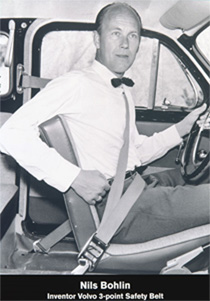Feed out, stretch, click and pull taut – and the risk of fatality or serious injury in a collision is cut by more than 50 percent.
To this day, the three-point safety belt remains the car’s single most important safety feature. It is the most widely used and most significant safety innovation in over 120 years of automobile history.
It was only towards the end of the 1950s that the car safety belt evolved into its current design, thanks to Volvo engineer Nils Bohlin.
There were different types of safety belts before that. Back in the 1930s, US doctors were beginning to impose demands that cars should be equipped with safety belts.
The two-point lap belt was the most common solution, but there were also different variants of the three-point safety belt. The problem was that they did not sufficiently protect their users, especially not at high speeds.
Former aviation engineer Nils Bohlin – who worked on the development of catapult seats, among other things, before moving to Volvo – had gained a good understanding of the forces generated in a collision.
The belt must absorb force in the right area – across the pelvis and chest where the body is strongest. At the same time, it must be easy to use and adjust.
The most important properties of Nils Bohlin’s design were that the system consisted of a lap belt and a diagonal body belt, that the belt straps were anchored at a low attachment point beside the seat, that the belt geometry formed a “V” shape with the point directed toward the floor, and that the belt stayed in position and did not move under load.
The very same principles apply to this day – every time you use the belt.
On the Nordic market, the Volvo PV544 and Volvo Amazon (120) were the first cars to feature this world innovation. Volvo was thus the first car maker to equip its cars as standard with three-point safety belts. The invention was patented with what is known as an open patent that is to say anyone who wanted was granted free use of the design.
A giant step towards increased safety had now been taken, but the three-point safety belt still did not achieve an immediate breakthrough. It would take another few years before the vast majority of customers and the rest of the automobile industry realised the safety belt’s effectiveness as a lifesaver.
In 1963, Volvo launched the three-point safety belt in the USA and on other markets. Ahead of the launch, Volvo conducted sled tests and crash tests with cars featuring various types of safety belts. The results were crystal-clear: Volvo’s three-point belt gave by far the best protection to the car’s occupants.
A few years later, in 1967, Volvo presented its ground-breaking “28,000 Accident Report” at a traffic safety conference in the USA. The report was based on data from all collisions involving Volvo cars in Sweden over a period of one year.
The report showed clearly that the safety belt saved lives and that it also reduced injuries by about 50-60 percent. And the world finally began to take notice.
Today the three-point safety belt is fitted to cars the world over. Volvo introduced this feature as standard in both front and rear seats as far back as 1967.
The modern safety belt is the cornerstone of the car’s interior safety system, working alongside additional features such as airbags, belt pre-tensioners and force limiters.
The belt positions itself correctly in an impact – the pre-tensioner tightens the strap across the torso. It then gives at exactly the right moment so that the body can be restrained as gently as possible. All within a few thousandths of a second.
It is difficult to give an exact figure for how many lives the safety belt has saved – there are no globally coordinated traffic safety statistics. However, it is estimated that more than a million people owe their lives to the safety belt, and it has saved many times that number of people from serious injury.
Remember! Everyone in the car should wear the safety belt. Click! Every time.









